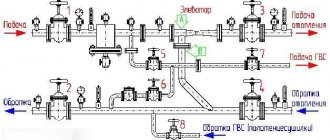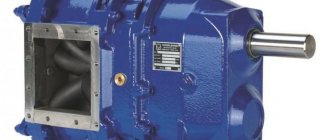We know that geothermy is the heat of the Earth, and the concept “geothermal” is often associated with volcanoes and geysers. In Russia, geothermal energy is used primarily on an industrial scale; for example, there are Far Eastern power plants that operate using the heat of our planet.
Many people are sure that making geothermal heating at home with their own hands is something out of science fiction. Is not it? But this is absolutely not true! With the development of modern technologies, the domestic use of “green energy” has become quite possible.
We will talk about the operating principles of alternative heating, its advantages and disadvantages, and compare it with traditional heating systems. You will also learn about how to position the heat exchanger and how to install geothermal heating with your own hands.
Advantages and disadvantages
Geothermal energy, the reserves of which are so large that only 1% hidden in the earth's crust with a total depth of 10 km can provide a volume 500 times greater than all the world's oil and gas reserves.
There are four main types of geothermal energy:
- This is the heat of the earth from shallow depths, used by heat pumps.
- The energy of hot steam, water in the earth's crust, currently used to produce electricity.
- Heat coming from deep layers without the presence of water and magma energy accumulated in volcanic zones.
- The use of this amazing gift of nature is determined only by the existing level of technology, technological capabilities and economic calculations.
Modern designs of geothermal heating systems have both positive and negative aspects.
The main negative point is the cost. But this only seems at the initial moment. All costs are recouped, according to various data, in 4, 5 years. This is due to the fact that modern heat pump models use much less energy to operate than any other heating system. When consuming 1 kW of electricity, their output is 5 kW.
Positive points:
- They do not burn fuel and do not produce harmful emissions of various compounds into the environment.
- Minimum maintenance costs with high efficiency.
- Environmental Safety.
- Reliable fire safety properties of the system.
A few historical facts
When the oil crisis broke out in the 70s of the last century, a burning need for alternative energy sources arose in the West. It was at this time that the first geothermal heating systems began to be created.
Today they are widespread in the United States, Canada and Western European countries.
Image gallery
Photo from
Prospects for geothermal heating
Dimensions of the indoor unit of the geothermal system
Cost of installation and operation of a heat pump
Environmental priorities of heat pumps
For example, in Sweden they actively use water from the Baltic Sea, whose temperature is +4°C. In Germany, the introduction of geothermal heating systems is even sponsored at the state level.
When we mention geothermal energy sources, we always imagine a valley of geysers or volcanoes, but the sources we need are much closer. And they will help us stay warm in winter and cool in summer.
In Russia there are Pauzhetskaya, Verkhne-Mutnovskaya, Okeanskaya and other geothermal power plants. But there is very little evidence of the use of Earth's energy in our private sector.
Pros and cons of geothermal heating
Geothermal heating became relevant in America during the crisis in the 80s. Initially, installation of installations cost a lot of money and such heating was used exclusively by wealthy people, but later geothermal heating became more accessible for mass use by the population. Advantages of using geothermal heating in a private home:
- Geothermal energy can be obtained and subsequently used almost anywhere;
- the supply of this type of heat is unlimited;
- the use of such energy is considered the most sustainable;
- geothermal energy does not contain various types of harmful emissions from the combustion of carbon dioxide;
- heating based on a geothermal installation does not require constant maintenance of the house;
- heating is considered free for the home owner;
- installation pumps take up much less space than similar thermal installations; a geothermal pump requires about the same amount of space for installation as, for example, a refrigerator;
- geothermal energy helps both heat the room and, if necessary, cool it; the operating principle is similar to the operating algorithm of air conditioners;
- If desired, such heating can be installed in conjunction with other heat supply systems, for example, with a gas system, diesel or powered by solar energy.
Despite a number of positive aspects of using this type of heating, geothermal installations also have their disadvantages, the main ones being:
- high costs for installation of the entire system;
- long payback period.
Such shortcomings of the heating system pale in comparison with the current trends in the global rise in prices of various types of fuel. Of course, the payback period is long, but over a hundred years, a geothermal installation will show all its advantages and prove its efficiency in practice. This type of heating has already been appreciated in a number of European countries and America. For example, in Sweden, about 70% of private homeowners chose just such a system for heating.
pros
The functioning of such heating systems is carried out on a qualitatively new and unusual fuel - the energy of the bowels of the earth is used for air conditioning and heating of a private home. This energy creates optimal and comfortable living conditions, and also does not pollute the environment with harmful substances and waste. The house is heated using free energy; for 1 kW of electricity, the system returns 4-5 kW of heat
Geothermal heating of a country house operates efficiently and safely without any combustion processes, so there is no risk that the system could catch fire or explode.
An equally important advantage is that there is no need to purchase additional hoods and chimneys, which may be required to ensure the smooth functioning of other types of heating systems. During heating operation, no harmful fumes or odors are emitted from the ground, such a system does not make unnecessary noise, and it does not take up much space.
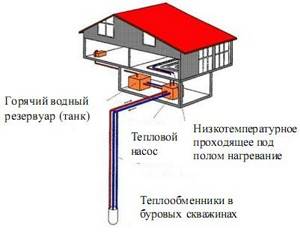
Geothermal units, unlike solid fuel and liquid fuel systems, are practically invisible to people; they do not destroy the integrity of the facade and interior of the house. There is no need to waste time thinking about issues such as storage, delivery and purchase of fuel, since the planet’s energy is inexhaustible.
Another very remarkable fact is that with the help of geothermal pumps you can heat rooms in winter or cool a cottage during hot weather.
If you need to heat your house with the heat of the earth, then it is also worth considering its financial side. Let us immediately note that the installation process of such a system will require greater costs compared to diesel and gas equipment.
In contrast, it can be noted that the level of electricity consumption is much lower, so that in the long term, the economic feasibility of purchasing geothermal equipment is visible to the naked eye. According to the developers, for every kilowatt of electrical energy spent, up to five kilowatts of thermal energy will be returned.
Pros and cons of geothermal energy
Geothermal heating gained popularity in America during the crisis of the 1980s. Such heating was available only to rich people, since the installation of such heating cost a lot of money, but over time any category of the population can afford it.

The main advantages of geothermal heating in your own home are:
- This thermal energy can be captured and used almost anywhere;
- The type of such heat is unlimited and is considered the most stable;
- Geothermal energy does not contain harmful substances of various kinds during the combustion of carbon dioxide;
- Installation of such a system does not require regular maintenance;
- Such heating is free for the owner of the house;
- Installation of the pump takes up less space than similar thermal systems;
- A system of this type can heat and cool a room and operates on the same principle as an air conditioner;
- If necessary, the installation of such a system can be performed with another heating system, for example: a gas or diesel system.
Even so many positive aspects of a geothermal heating system do not overshadow the negative ones.
The main disadvantages of such a heating system are:
- Installation of the entire system has very high costs;
- A geothermal heating system pays for itself over a long period of time.
Geoheating also has disadvantages, the most important one being not only that all the actions performed are expensive, but also that by using groundwater, you exhaust natural sources. But these disadvantages are not very noticeable compared to our prices for different types of fuel. The payback period for such an installation takes a long time, but after a long time the geothermal system will show you all its advantages and prove its economy. This type of heating has decent ratings in many European countries. For example, in Sweden, more than 70 percent of home owners choose this particular heating system.
Conclusions and useful video on the topic
If it’s easier for you to perceive visual information, then this video will allow you to see with your own eyes exactly how a geothermal system functions, as well as learn more about who benefits from this type of heating and why.
We invite you to watch a short video in which the owner of a horizontal subsoil collector will talk about his impressions of its operation. Additionally, by watching this video, you will learn about the ongoing costs associated with operating a geothermal heating system.
Each owner of a private home chooses for himself whether to buy the services of resource supply organizations or rely only on himself. In doing so, he is guided by a whole list of considerations.
The goal we have set for ourselves is not to push you to a ready-made conclusion, but to share information about options for solving the problem facing you.
Do you have anything to add or have questions about geothermal heating of a private home? You can leave comments on the publication. The contact form is located in the lower block.
Operating principle and components
A geothermal heating system is a complex engineering complex of structures that requires large material and time costs, but upon closer examination it turns out that once installed, such a heating scheme is completely capable of covering the need for heat and hot water supply in a house of up to 150 square meters. These systems are becoming widespread in Western Europe, where environmental friendliness and economic benefits come first.
Let's consider the principle of operation of geothermal heating and its main components in order to come to an understanding of how justified such systems are in everyday life.
Heat pump
The heart of the system. It is possible to do geothermal heating at home with your own hands, but this element is best purchased separately. It is worth noting that before starting to purchase equipment and materials, it is necessary to carefully calculate the total capacity of the system, its output and the ratio of this indicator to the thermal consumption of the building.
If this is not done on time, all further work may go to waste. The most crucial aspects of the entire complex of measures are the correct calculation of the circuit capacity and the purchase of appropriate equipment.
The heat pump consists of a compressor and a pressure reducing valve, which provide a potential difference in individual sections of the heat pump circuit. Inside the pipes there is freon, which, thanks to the work of the compressor, receives acceleration and, passing through the valve, accelerates its movement. This leads to a significant rise in temperature in the area in front of the compressor; it is from this area, with the help of heat exchange, that the main heat is taken for heating the premises and hot water supply.
The circuit is closed and its whole task is to increase the natural temperature of the coolant coming from the external circuit from seven to fifty-five degrees Celsius. This happens due to the process described above of accelerating freon under pressure in a closed circuit with its passage through the valve.
The heating unit is usually located in the basement or ground floor, with an external temperature within fifteen degrees above zero, this maintains its stable operation.

The most important process before installing a heat pump is to carry out all the calculations correctly; if there is an error, all the work can go to waste.
External contour
It is another closed circuit in which antifreeze moves through pipes, moved by a circulation pump. The main part of the circuit is located at a depth of up to 3 meters underground, if we are talking about a horizontal design of the system, in which the pipes of the external circuit are placed horizontally on a large plane.
It can also be located at the bottom of a reservoir, but only in regions where winter temperatures do not drop below zero.
The system described above requires installation at the stage of pouring the foundation, which is not always possible. In the case when it is necessary to install geothermal heating of a country house on an already built-up site, wells are drilled to a depth of thirty to one hundred meters. By the way, the thermal energy output of vertical systems is significantly higher, but their cost is an order of magnitude more expensive due to the involvement of equipment for drilling wells .

It is advisable to install the external contour at the stage of pouring the foundation, otherwise it will be a more labor-intensive and expensive process.
External contour
It serves directly to heat the interior of the house and provide hot water supply.
Heat collected from the ground, transferred to the heat pump, accelerated and increased in its closed circuit, is transferred through a heat exchanger to the internal network of the house, which can consist of heated floors, baseboard heating, air heating on water collectors and other elements of the system.
You should choose exactly how to implement geothermal heating with your own hands only after carefully studying the area and the conditions in which this heating scheme will operate. To do this, it is necessary to measure the soil temperature in the area under the house, at different periods during the winter, at different depths.
Do it yourself: what and how
If you are going to install geothermal heating yourself, then it is better to buy the external circuit ready-made. Of course, we are only considering ways to horizontally position the external heat exchanger: under the surface of the soil or under water.
It is much more difficult to install a vertical well collector yourself if you do not have the equipment and drilling skills.
A heat pump is not a very large piece of equipment. It will not take up much space in your home. After all, in size it is comparable, for example, to a conventional solid fuel boiler. Connecting the internal circuit of your home to it is not a difficult task.
In fact, everything is done in exactly the same way as when organizing and distributing heating using traditional heat sources. The main difficulty is the design of the external circuit.
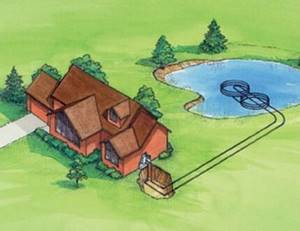
This arrangement of the house relative to the pond is more common. The main thing is that the reservoir is no further than 100 meters from the cottage
The best option would be to use a reservoir if one is found at a distance of no more than 100 m. It is necessary that its area exceed 200 sq. m. m, and the depth is 3 m (average freezing parameter). If this body of water does not belong to you, then obtaining permission to use it may become a problem.
If the reservoir is a pond that is on your property, then the matter becomes simpler. The water from the pond can be temporarily pumped out. Then work on its bottom can be done easily: you will need to lay the pipes in a spiral, securing them in this position.
Excavation work will only be needed to dig a trench, which will be needed to connect the external circuit to the heat pump.
After all work has been completed, the pond can be filled with water again. In the next hundred years, the external heat exchanger should work properly and not cause trouble to its owner.
If you have at your disposal a plot of land on which you just have to build housing and grow a garden, it makes sense to plan a horizontal ground-type heat exchanger.
To do this, you should make a preliminary calculation of the area of the future collector, based on the parameters already indicated above: 250-300 sq. m of collector per 100 sq. m of heated area of the house.
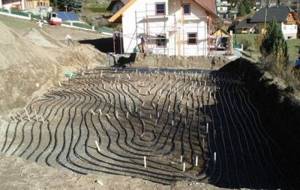
If you have a plot without buildings or vegetation that you would like to preserve, the soil can simply be removed when constructing an external horizontal soil contour: this is easier than digging trenches
The trenches in which the circuit pipes are to be laid must be dug below the soil freezing level.
Better yet, simply remove the soil to the depth of its freezing, lay the pipes, and then return the soil to its place. The work is labor-intensive and complex, but with great desire and determination, you can complete it.
Heat exchanger location options
Geothermal heating due to the heat of the earth differs according to the location of the equipment. The heat exchanger can be installed vertically and horizontally. For horizontal installation, laying is carried out in a pit or on the bottom of a reservoir, laying in the form of a coil. Vertical installation of heat exchangers is the installation of equipment in mines or wells.
Let's take a closer look at both options:
- Vertical placement requires a depth of 50-100 meters, where the year-round soil temperature does not drop below +10 C. To install the heat exchanger, wells are drilled, where the external contour of the system is formed. The pit depth can reach 200 m; the parameters of the well will depend on the individual geological parameters of the area. The service life of the system is from 100 years. If the vertical placement involves the extraction of heat from the water, then 2 water-bearing wells are drilled, liquid is taken from the production well, which, after being worked off in the heating system, is drained into the second, receiving well.
- When the collector is placed horizontally, there will be a lot of excavation work, and first you need to find out the freezing point of the soil. Pipelines are laid below the freezing point, for which trenches are dug. The area of soil treatment to form the system is large, for example, for a house of 250 m2, you need to use approximately 600 m2 of heat exchanger, that is, 6 acres.
Immersion of a horizontal heat exchanger in a reservoir
This method requires a special location of the household - at a distance of about 100 m from a reservoir of sufficient depth. In addition, the specified reservoir should not freeze to the very bottom, where the external contour of the system will be located. And for this, the area of the reservoir cannot be less than 200 square meters. m.
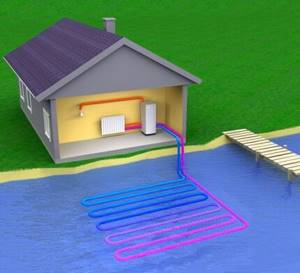
This option for placing a heat exchanger is considered the least expensive, but such an arrangement of households is still not common. In addition, difficulties may arise if the reservoir is a public property.
The obvious advantage of this method is the absence of mandatory labor-intensive excavation work, although you still have to tinker with the underwater location of the collector. And special permission to carry out such work will also be required.
However, a geothermal installation using water energy is still the most economical.
Methods for implementing a geothermal installation
This type of heating differs in the way the heat exchanger is installed. Today there are three varieties in use:
- Vertical heat exchanger: it is compact and has a higher installation cost compared to other types. To install a vertical heat exchanger, you do not need to use a large area, but you will need to use specialized drilling rigs. Depending on the chosen technology, the depth of the finished well can reach up to 200 meters, the minimum is 50 meters. The service life of the system is up to one hundred years. It is beneficial to install this type of geothermal heating if it is installed on an already developed area. The landscape of the area will remain virtually untouched.
- Horizontal heat exchanger: This type is used quite often. When installing a horizontal heat exchanger, the pipes are laid to a sufficiently large depth, which necessarily exceeds the level of soil freezing. The main disadvantage of using exactly this type of wiring is that it requires a large area to be used for installing the collector. It is difficult to install such a system on an already developed site.
- Water-based heat exchanger: this installation is the most cost-effective among all the variety of geothermal heating, as it works using the energy of water bodies. This system is relevant for those homeowners who have a body of water hundreds of meters away. Such a heat exchanger is the most profitable, which makes its installation the most appropriate among all types of similar heating.
Installation and Installation
It is better to install such a heating system not on your own, but by engaging specialists, at least for certain types of work, if you are confident in your own abilities.
The main stages are as follows:
- Calculation of the internal circuit of the heating system. This includes in detail the total length of the pipeline, the number of radiators, the creation of heated floors, and the use of heat to produce hot water in the house.
- Calculation of the laying depth of external circuit pipes for the selected type of heat exchanger. It is necessary to take into account the geodetic data of the area.
- Drilling the required shaft and installing pipes. If there is no centralized water supply at the same time, the easiest way is to solve the issue of creating other water wells. The technology for their creation is different and requires special knowledge.
- Selection and installation of the required heat pump model.
- Installation of automatic devices that monitor the operation of the entire system and regulate the microclimate in any area of the room.
Calculations
The main parameters that are taken into account in any calculations are:
- temperature (depths from 15-20 m or more warm up from 8 to 100 degrees, depending on the conditions);
- extracted power value (average value - 0.05 kW per 1 m);
- the influence of climate, humidity and contact with groundwater on heat transfer.
What is very interesting is that completely dry rocks emit no more than 25 W per 1 m, and if there is groundwater, this figure rises to 100-110 W. We must not forget that the standard operating time of a heat pump is 1800 hours per year. If you exceed this figure, the system will not become more efficient, but its wear will rapidly increase. What is much worse, excessive exploitation of the thermal resource of the subsoil leads to its cooling and even to the freezing of rocks at the working depth. Following this, the soil may subsidence, sometimes damaging working pipes and above-ground structures.
Costs and payback prospects
The costs of equipment and its installation during the construction of geothermal heating depend on the power of the unit and the manufacturer.
Everyone chooses a manufacturer based on their own considerations and information about the reputation and reliability of a particular brand. But the power depends on the area of the room to be served.

This figure summarizes the benefits of using a geothermal heating system. It is precisely this ratio of incoming and outgoing energy that allows the system to first quickly pay for itself and then save its owner’s money (+)
If we take power into account, the cost of heat pumps varies in the following ranges:
- for 4-5 kW – 3000-7000 conventional units;
- for 5-10 kW – 4000-8000 conventional units;
- for 10-15 kW – 5000-10000 conventional units.
If we add to this amount the costs that are needed to carry out installation work (20-40%), then we will get an amount that for many will seem absolutely unrealistic.
But all these costs will be recouped in a very reasonable time frame. In the future, you will only have to pay minor expenses for the electricity needed to operate the pump. And it's all!
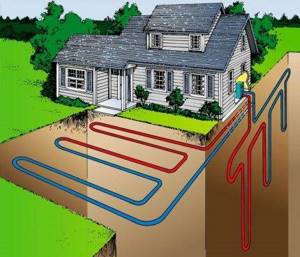
Due to the insufficient efficiency of geothermal systems for heating residential buildings, they are used as an addition to the main heating networks or built in complex with two or more heat exchangers
As practice shows, geothermal heating is especially beneficial for houses with a total heated area of 150 square meters. m. Within five to eight years, all costs for installing heating systems in these houses are fully recouped.
If geothermal heating is not particularly in demand among owners of private houses, then the effectiveness of solar systems has already been appreciated by residents of the southern regions. The technology for constructing solar heating is quite simple, and its efficiency and practicality are confirmed by many years of experience in use by Western countries and our compatriots.
Geothermal heating: price
Below we have given average prices for equipment and installation work for installing such a system in a house. conditions: the area of the heated room is approximately 200 square meters, the thermal power of the pump is 15 kilowatts. Prices in rubles.
- Thermal compressor - about 260,000.
- Buffer – 45000.
- Indirect heating capacity – 50000.
- Circulation pump – 10000.
- Pipeline, fittings and other auxiliary equipment - 25,000.
- Electrical wiring, insulation – 10,000.
Add to all this the cost of installation - at least 60,000. It turns out that all equipment with excavation work and installation of the boiler room will cost an average of 480,000 rubles.
How promising is geothermal heating?
Heating systems of this type are not very popular among the population due to their high cost. The prices we have given above are just the minimum. In general, if you install such a turnkey system, its cost can rise sharply to one million rubles! As is known, 1/3 of this amount is occupied by a heat compressor.
And here I would like to cite Western European countries as an example. In them, if anyone doesn’t know, if the owner of the site has equipped his home with geothermal heating, that is, self-healing, then the government is obliged to compensate him for a certain part of the money spent.
At the same time, such a system can pay for itself in just five years. In addition, it does not require human intervention during operation, due to complete autonomy, so it is not only economical, but also extremely convenient, especially compared to other heating methods.
Features of installation of such systems
Without a doubt, there is hardly anyone willing to drill a one and a half kilometer well in order to heat a private house. But if you live in an area where hot water literally bubbles out of the ground and this has nothing to do with utilities, then you can install geothermal heating on the site without any special costs. That is, not very big.
Stage 1. First you need to determine exactly where and at what depth the underground hot water is located.
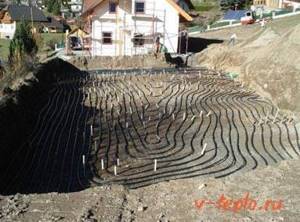
Stage 2. Then you need to drill a well of the appropriate depth, or preferably two at once. One of them will be intended to supply housing with hot water, and the second will be designed to drain already cooled water into the soil.
Stage 3. The last stage is the installation of the heat pump and its further configuration. Moreover, you need to install the pipeline in accordance with the diagrams given in this article.
The heating equipment that is installed in the house itself will be quite traditional. As already mentioned, this can be either a warm floor or the most ordinary radiators.
Note! Everyone knows that the water in geothermal springs is hardly pure and distilled. It may contain salts and other mechanical impurities, which is why it cannot be supplied directly to the heating lines
Moreover, some sources contain water that is too hot, which can simply destroy pipelines. In order to avoid all these troubles, geothermal water is used to heat the water in the system, that is, the water in this case is heated by other water, and the latter enters the heating devices. This is also called indirect heating method. It is good because it allows you not only to heat the room, but also to take a hot shower - in most sources the amount of water is more than enough for this.
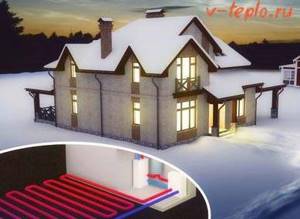
The effectiveness of such a system will very quickly cover all the costs of its installation. And if you consider that it is also completely safe in environmental terms, and the heat source is constantly self-replenishing, then one conclusion arises: geothermal heating of the house is recommended for everyone who has access to hot water on the site.
Video description
Geothermal heating at home: pros and cons.
Important! When laying the contour horizontally, it is recommended to find out the exact depth of soil freezing, since the structure must be installed below this mark.
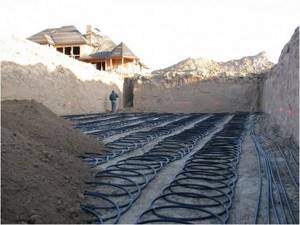
Spiral-shaped method of laying the external contour of geothermal heating







